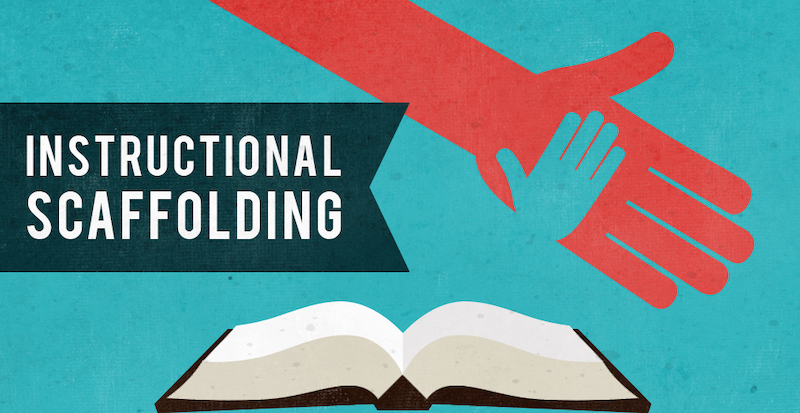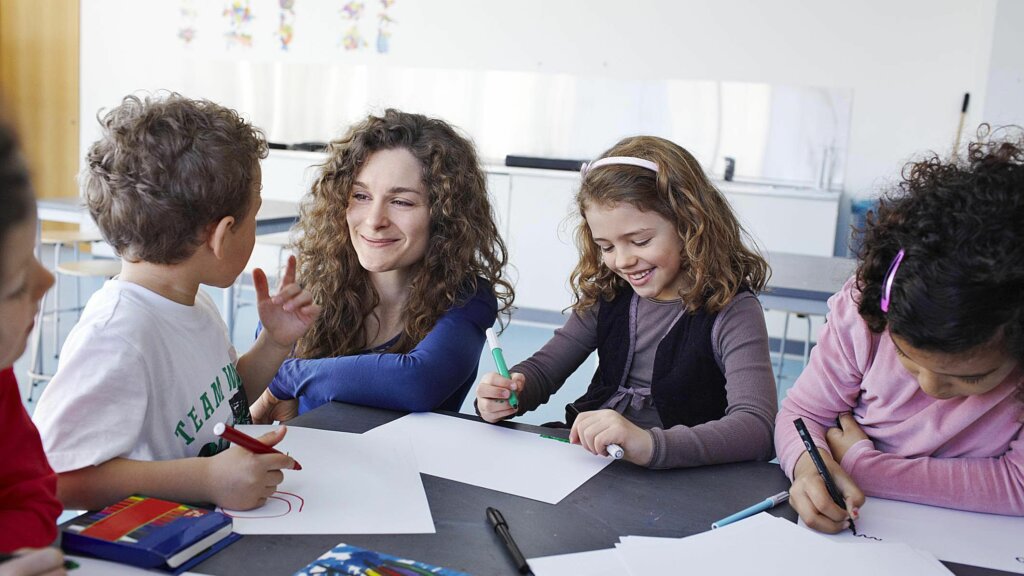In today's classrooms, much is made about the unique ways students solve problems—from those that are hypothetical to those that affect daily life. Students also learn in different ways with some of them excelling in self-paced learning, others needing collaborative experiences, those who prefer to work independently, and still others who fall into a bunch of other categories. Lately, scaffolding STEM experiences has become a huge topic across education since it allows children to gain valuable hands-on experience. With teachers initially providing support and helping students experience independent learning, scaffolded STEM lessons ultimately help kids build a growth mindset through self-contained problem solving.
Why Scaffold Instruction?
Helping students think about learning as a mixture of independent and guided experiences can help them view their education differently. When we use the term ‘scaffolded’ in this context of classroom instruction, we’re typically referring to any teaching or learning approaches that gradually evolve and ultimately provide students with more options when leading their own learning. In terms of STEM education—and its hands-on elements—there are plenty of opportunities for instructors to help students progress using a scaffolded system. One reason why both teachers and students advocate for more scaffolded instruction in STEM is because it keeps student needs at the center while helping them grow independently.
Scaffolding tips for different scenarios.
Scaffolded instruction often resembles constructivism and educators use these strategies to help students boost their problem-solving abilities and their ability to learn more on their own. By intentionally scaffolding STEM instruction, teachers can help students achieve more in the classroom and help boost their cognitive development. This, in turn, could help children achieve more in other curriculum areas in addition to STEM. Educators could also leverage different strategies for scaffolding learning based on the various outcomes they hope to achieve. Also, assessment is valuable when scaffolding instruction because it helps teachers determine when to step back or when to offer assistance.
The teacher's role in scaffolding STEM learning.
At the most basic level, scaffolding their instruction should help children build key skills that enable them to become independent learners. With greater independence, students can learn more with less hand holding and added freedom to explore their curiosities. We’re not saying that teachers should fully step aside when scaffolding instruction, however. In fact, we’re saying the opposite. Words of encouragement are incredibly beneficial in scaffolded STEM learning and even a few, brief points of advice before children begin working can help a great deal. Students may feel unsure at first but they still learn from their immediate successes and even more from initial struggles.
Strategies for Scaffolding Student Learning
While we certainly focus on STEAM education, there are definitely opportunities to use a scaffolded model throughout the curriculum. When scaffolding instruction, educators can typically support each student with targeted instruction, creating a stronger connection between scaffolded and personalized learning. These personalization strategies typically involve breaking learning down into manageable chunks—chunks that will vary for almost all students. This also provides students with a concrete structure for their learning and reinforces how they understand what they should accomplish. Also, scaffolding the lessons and classroom content helps teachers get away from mandates and structure since kids can ask for help when they need it and go on their own when they don’t.
Using show and tell and tapping student knowledge.
There is a relationship between scaffolding and personalization because, in order for educators to know how to scaffold the lessons, they must know where their students are in terms of progress. There are also various strategies teachers could use to scaffold instruction in education, including starting with show and tell. Students are usually more interested when they can see something as opposed to hearing about it, so educators who are hoping to integrate scaffolded STEM models should demonstrate the expectations they have whenever possible. Another strategy is tapping students’ prior knowledge—particularly by connecting classroom concepts to events in their lives. Especially when scaffolding STEM lessons, launching learning from prior knowledge often helps students connect to it and take ownership.
More scaffolding tips and tricks.
Other strategies for scaffolding in education include letting kids talk, pre-teaching vocabulary, using visual aids, and checking for understanding. Talking helps kids better process new information and it's crucial to ensuring that they can articulate what they’ve learned. By pre-teaching vocabulary, students should better understand what they’re reading independently without confusion from new words or concepts decreasing interest. Visual aids within scaffolded lessons help students visually represent ideas, organize information, and grasp key concepts using guided thinking. Finally, pausing and reviewing can help teachers check for comprehension as they confirm students understand all topics they've introduced. With some specific and open-ended questions, teachers can ensure kids absorb information while letting them control the pace.

The Evolving Features of Scaffolded Instruction
Over time, strategies and outcomes for scaffolding instruction have evolved to meet student needs and to align with contemporary learning. Scaffolding also often includes one or more specific elements, like intent, appropriateness, structure, collaboration, and internalization. Intentionality helps give kids clear purpose to fuel their work, appropriateness involves outside assistance from the teacher that leads to eventual student mastery, and structure provides a natural sequence for progression through projects. On the other hand, collaboration allows students to respond to teacher feedback and improve their efforts while internalization helps them conceptualize patterns, leading to external task scaffolding—just some features of scaffolding.
Creating scaffolded and student-centered learning.
As time has passed, educators have tried incorporating other elements when scaffolding STEM instruction, including those that are more student-centered. Rather than stating what intentions behind projects should be, teachers can help students determine their own rather than assigning them. They can also model some behaviors for students to emulate, offer a starting point for their explanations, and step in only to verify that students understand what they’re learning. This also helps students use a whole-task approach and share the specific goals they hope to achieve. With greater student participation, the projects are more student-centered and these added elements of scaffolded instruction are noticeable.
Boosting collaboration when scaffolding STEM learning.
Today, scaffolded instruction has a new identity with newer elements for helping students learn in the best ways. Teachers have noticed the benefits of breaking projects down into smaller parts so that they're more manageable, for example. Many teachers also have students think out loud, which helps them to verbalize their thought processes for completing specific challenges. This also helps make scaffolded learning more collaborative, allowing kids to talk among each other and create a helpful dialogue. Some other strategies have followed these existing ones, including getting more specific with students' background knowledge and using more concrete coaching or questioning prompts to drive student engagement.
Steps for Scaffolding Instruction in the Classroom
One of the simplest ways to explain scaffolded instruction—both in STEM and in general education—is to think about it like a progression. Your ultimate goal is equipping students with skills and confidence to lead their learning and certain approaches help teachers succeed. Teachers may find success by demonstrating an I do, we do, you do model when it comes to scaffolding instruction. This involves initially demonstrating a project or a concept to students followed by those students briefly working together before they are free to show what they know by completing their work independently.
Different phases of scaffolding STEM instruction.
In the beginning (or the I do phase), educators can focus on demonstrating some skills they'd like students to develop. This allows them to connect certain skills with mindsets and helps them create a foundation for better understanding relevant topics. When it comes to using the we do model, teachers could offer guided practice that combines teacher-led and independent learning. They could do so in different ways and share feedback on what they see while monitoring children from the side. And, in the you do model, teachers can utilize student choice and let students choose their course of action. They'll become more responsible for their work, their mistakes, and the skills they build independently, which all help them grow.
Visual demonstrations of the problem-solving process.
One distinction in scaffolding STEM instruction is that showing students what to do is often more effective than how-to lectures. When teachers demonstrate projects or examples, they can verbally reinforce the key purposes of the work and remind children what steps they should include in their problem-solving process. Some teachers even deliberately make mistakes when demonstrating so that students recognize they may need to retune problem-solving approaches sometimes. This can also give them some more confidence in freely exploring different problem-solving methods. Ultimately, there aren't many set-in-stone requirements for the various stages of scaffolding and teachers can start with active demonstrations to show students all they need to know.

Helping All Students with Scaffolding
For students, scaffolds might include temporary supports that teachers use to make sure they're on track with learning objectives. When teachers put scaffolding into practice, however, they’re not doing so just to modify curricular content or accommodate student wishes. Rather, it helps kids process learning in a new way while increasing the likelihood they'll retain what's most important. When integrating standards-based goals in a well-designed curriculum, teachers are heading in the right direction as they help boost learning. Though it may seem like scaffolding learning is a bit like holding students' hands, in reality, it’s an effective strategy to help them build academic independence while remaining focused.
Tying scaffolding to key learning metrics.
As we alluded to, scaffolding learning is similar to personalizing learning and that’s one mindset educators have regularly adopted. In designing the scaffolds for students, educators should be mindful of each one's individual strengths and what they struggle with. This will help teachers provide more meaningful scaffolds while tailoring them to what they individually need. Scaffolds should also remain tied to relevant academic standards so that students are still learning what they need to know. They should also tie them to specific learning outcomes they want to achieve with each lesson or project. This helps students to zone in on the most important concepts and reasons for completing particular projects.
Additional ways of scaffolding STEM instruction.
Other ways for teachers to maximize scaffolding in STEAM lessons is by applying these strategies to help kids meet every learning objective and using them to provide support they need to get there. At times, the scaffolds will be necessary for students to complete a particular assignment and that is okay. Fortunately, however, this isn't always necessarily the case. Scaffolds should be temporary as well and it’s sometimes beneficial to change them up when the situation is right. By ensuring scaffolding is available and aligns to assignments, however, teachers can help students achieve more than simply completing work. And, they can start building independent learning skills, identify where to find support, and try new problem-solving strategies that will help them in the future.
For the latest EdTech, STEM, and 21st century education news, follow us on Twitter and Instagram. Like us on Facebook, too, or sign up for our newsletter for our latest product announcements and offerings. If you have an idea for an Eduporium Weekly theme, send us a message on social media or comment below.




1 Comment